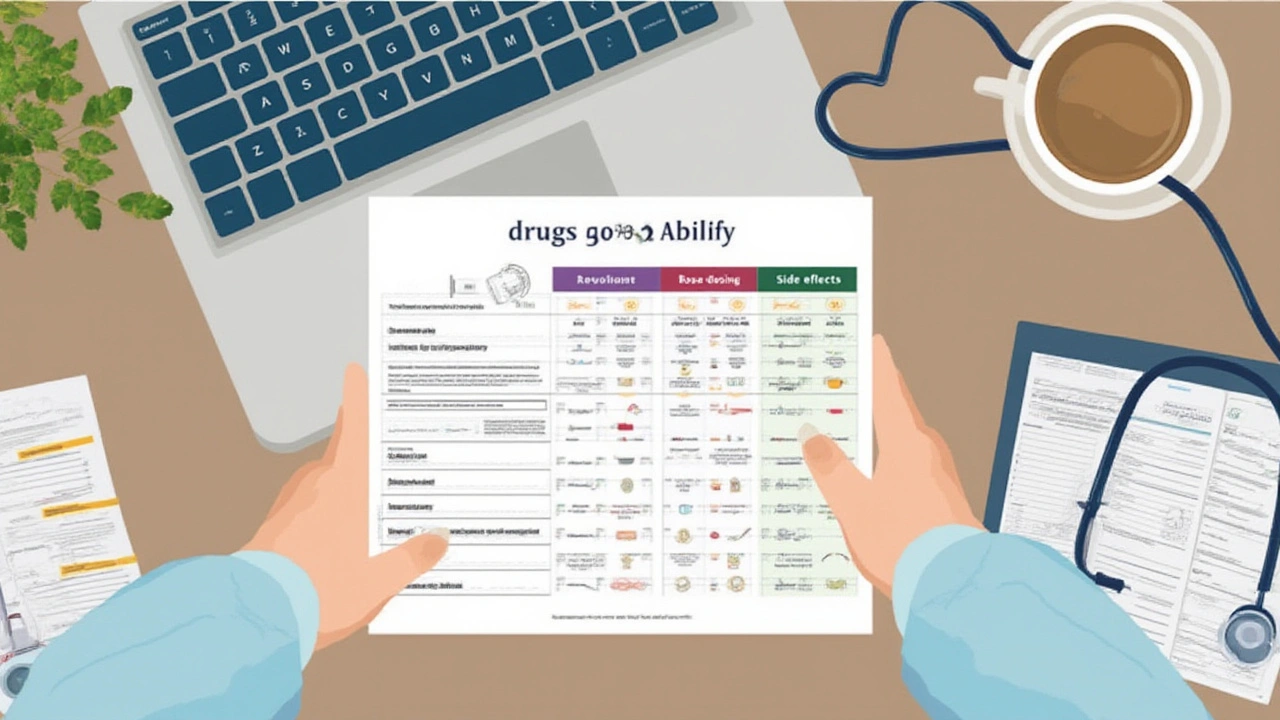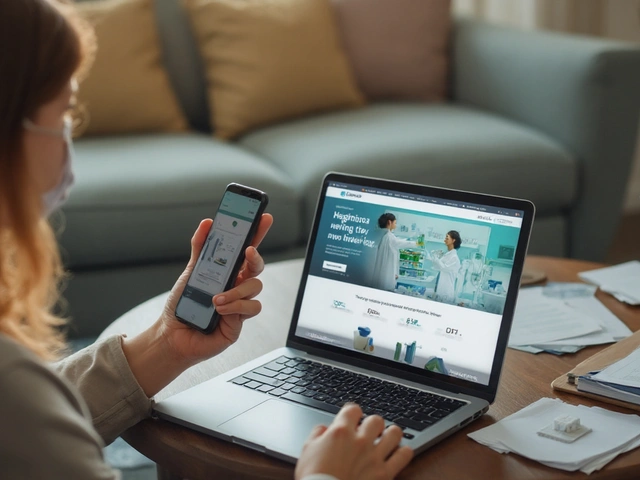The landscape of antipsychotic prescribing is full of close calls and small differences that have huge impacts on people’s lives. Two patients with nearly identical diagnoses can have radically different outcomes, all depending on drug choice and titration. Here's what many don’t know: the subtle receptor profiles and dosing quirks in drugs similar to Abilify (aripiprazole) can turn one medication into a recovery tool, and another into a non-starter others dread to take. There’s little room for guesswork. Some drugs flirt with the same dopamine receptors as Abilify, others tweak serotonin systems in unique ways. Ready to get specific?
What Makes Abilify Distinct: Fast Look at Its Pharmacology
Abilify, or aripiprazole, has made its mark as a partial dopamine D2 agonist—a rare trick in the antipsychotic world. While most second-generation antipsychotics (SGAs) block these receptors entirely, Abilify tempers them: too much dopamine and it reins it in, too little and it nudges things back up. This "balancing act" is why it causes less sedation and fewer movement side effects than many old-school antipsychotics. It’s not just dopamine, though. Abilify also partially activates 5-HT1A serotonin receptors (which can help with mood and anxiety) and blocks 5-HT2A receptors. That’s a fancy way of saying it tries to modulate two key neurotransmitters, making it somewhat gentler for some patients. Aripiprazole’s half-life stretches to three days, so steady-state blood levels build gradually—that’s why rapid titration can backfire with agitation or akathisia. Despite its broad approvals—for schizophrenia, bipolar disorder, adjunct in depression, and even irritability in autism—not every patient thrives on it. Sometimes akathisia (that restless, can't-sit-still feeling) shows up and won’t leave. Or metabolic changes creep in quietly. That’s when you reach for the second stringers: the close alternatives often grouped as drugs similar to Abilify.
Comparing Mechanisms: Abilify and Its Pharmacological Cousins
When people say “Abilify alternatives,” they mostly mean the newer SGAs with similar receptor actions. Yet, even within this family, there are key quirks clinicians need to know. Brexpiprazole (Rexulti) may look almost like aripiprazole on paper (it’s even called the “me-too” molecule), but its affinity for 5-HT1A is stronger, and it antagonizes 5-HT2A receptors even more than Abilify. This can mean even softer mood modulation and sometimes less restlessness. Cariprazine (Vraylar) is another partial D2/D3 agonist with a stronger punch for D3, which is linked more to cognition and motivation than classic antipsychotic effects. So those with negative symptoms (withdrawal, apathy) may see more relief. Lurasidone (Latuda) brings a different approach: strong 5-HT7 antagonism (which can help with cognition) and a heavy serotonin focus, but not as much dopamine trickery. In contrast, drugs like risperidone and quetiapine (Seroquel) block D2 rather than modulate. So, they’re heavier on sedation and movement side effects. Atypical antipsychotics must always be weighed by individual history. For instance, those on lithium or with movement disorder risk—think older adults—may do better with a partial agonist rather than a blunt blocker. Choosing isn’t just about diagnosis. It’s about matching receptor profile and side effect tolerance to the person in front of you.

Side-by-Side Chart: Receptor Profile, Titration, and Dosing
Here’s a comparison table clinicians crave—specific, relevant, and stripped of pharma speak. You need this at-a-glance summary, especially when juggling patient histories and insurance formularies.
| Drug | Key Receptor Actions | Starting Dose | Target Dose (Adults) | Titration Notes | Common Side Effects |
|---|---|---|---|---|---|
| Abilify (aripiprazole) | Partial D2/D3 agonist, 5-HT1A partial agonist, 5-HT2A antagonist | 2-10mg | 10-30mg | Increase by 5mg every 1-2 weeks; watch for akathisia | Akathisia, insomnia, nausea |
| Rexulti (brexpiprazole) | Partial D2 agonist, potent 5-HT1A/2A antagonist | 0.5-1mg | 2-4mg | Increase by 1mg every week | Weight gain, somnolence, agitation |
| Vraylar (cariprazine) | D2/D3 partial agonist (high D3), 5-HT1A partial agonist | 1.5mg | 3-6mg | Increase every 1-2 weeks; very long half-life | EPS, nausea, insomnia |
| Latuda (lurasidone) | D2 antagonist, robust 5-HT7/2A antagonist | 20mg (with food) | 40-160mg | Increase by 20mg every week; take with 350+ calories | Somnolence, nausea, akathisia |
| Seroquel (quetiapine) | D2 antagonist, 5-HT2A antagonist, strong H1 antagonist | 50mg | 300-800mg | Increase by 50-100mg/day; highly sedating at low dose | Sedation, weight gain, metabolic syndrome |
One tip: don’t trust equivalent dosing when switching. For example, 10mg Abilify is not "equal" to 1mg Rexulti, even though their D2 potencies are close. Washout periods or gradual cross-tapering are key—especially for drugs with long half-lives like cariprazine (Vraylar), where active metabolites linger for weeks. Always recheck mood and movement symptoms after any dosing change. There’s real risk of sudden relapse or withdrawal symptoms if switched too quickly—especially with patients who are medication-sensitive or have a history of poor adherence.
Dosing and Titration: Real-World Tips for Clinicians
Fast titration may sound great in theory, but for SGAs with long half-lives, it’s a recipe for trouble. For aripiprazole, increasing by more than 5mg per week isn’t just aggressive—it invites akathisia, irritability, and sleep problems. Cariprazine, with its weeks-long half-life, is slow to build up in the body. Some patients don’t hit full therapeutic response for a month or more after you stop titrating. Readjust only after at least two weeks at a stable dose. Food is another issue. Lurasidone is one of the few that dramatically changes in absorption depending on whether the patient eats with it—always remind your patients to take it with at least 350 calories, or you risk dropping blood levels by half. Explaining the difference between partial agonists and antagonists matters: many patients expect sedation or close-to-instant calm, which they may not get from agents like Abilify or Rexulti but may expect from risperidone or quetiapine. In fact, quetiapine’s low-dose sedation makes it more of a sleep aid for some patients, but only at higher doses does its antipsychotic effect really show. Don’t set people up for disappointment. A fun fact for those who like numbers: while the antipsychotic effect of aripiprazole hovers around 90-94% D2 occupancy at clinical doses, the risk of side effects like EPS jumps above 80% occupancy. The “sweet spot” is narrower than most assume. That’s why some patients are exquisitely sensitive to even small dose increases. Personalize the titration plan, and always watch out for akathisia, a common reason for dropout. Beta blockers or dose slowing usually help, but sometimes nothing but switching agents fixes it.

Choosing the Right Alternative: Tips, Pitfalls, and Patient Factors
It’s so tempting to just swap one SGA for another when side effects show up. But each drug has its unique fingerprint. Brexpiprazole tends to be less activating and is a solid option when aripiprazole’s akathisia or agitation is intolerable. But, the price can be higher and insurance coverage spotty. Cariprazine is well-liked for patients with negative or cognitive symptoms—think lack of motivation, social withdrawal—because its D3 preference is supposed to help. But, its side effects include more frequent movement issues, especially at higher doses. Lurasidone is underused in the US but is a go-to in places like Japan because of its minimal metabolic side effects and cognitive benefits. Its potential to be taken as a monotherapy for bipolar depression puts it in a league of its own, but GI side effects hit some people hard. Some users switch to quetiapine or olanzapine when severe insomnia or agitation is present, but these drugs come with higher risk for weight gain and metabolic syndrome. Here’s a commonly overlooked fact: smokers can metabolize some SGAs faster (especially olanzapine and clozapine), but this isn't as much of an issue with aripiprazole or its cousins. Those with liver issues or elderly patients may need half-doses or slower titration. Always assess suicide history, pregnancy, and co-morbid cardiac or metabolic diseases before picking or switching an agent. If you want an expanded take on all things related to agents in this class, check out this updated summary about drugs similar to Abilify for clinical pearls tailored to tricky patient populations and rarer alternatives.






You know, I always thought that diving into the world of antipsychotics was like navigating a maze blindfolded, but this comparison chart thing? Wow, it feels like someone just turned the lights on! 😮
Taking a deep journey through receptor profiles, dosing tips, and side effects is honestly extremely useful, especially when clinicians sometimes get overwhelmed with so many meds to choose from. How much do you think the receptor profile really dictates side effects though? Also, could this be expanded more on real-world clinical applications? Because let's be honest, effects on a chart and what happens with patients aren’t always the same. 😊
Anyway, I hope more posts like this come around to demystify these complex meds. What about interactions with other medicines? It's always a tangled web with psychotropics, isn’t it?
July 19Katey Nelson